Opinion & Analysis
The blind spot of PGA Tour players: Long-iron play

With the PGA Tour’s season winding down to the final tournament of the year, there will be a faction of golfers fighting to make the top 125 on the Money List in order to keep their Tour Card for 2013. I have personally worked with a few PGA Tour players, their caddies and instructors on understanding the game from a statistical standpoint.
When I started the 2012 season working with these clients there were a couple of parts of our initial interaction that surprised me:
1) Each player had made it their goal to be ‘one of the best wedge players on Tour.’
2) Each client initially did not buy into me telling them that in the grand scheme of things, full shot wedge play is not overly important. Particularly on the PGA Tour.
With the PGA Tour’s ShotLink data, the numbers are on display for statisticians like me to decipher the level of importance of each part of the game of golf. It’s very similar to the movie Moneyball and the approach Oakland A’s General Manager, Billy Beane, utilized to build his team based on the cold, hard numbers instead of traditional baseball axioms. But even better, there are far less “moving parts” in the game of golf, making the numbers more distinct and easier to see the correlation to success on Tour.
Despite that, there is still plenty of resistance to approaching the game of golf from a metrics standpoint and every year there are about 75 full time PGA Tour golfers wondering where their entire season went wrong.
***
My development into metrics and the game of golf actually started back when I was only five years old. I immediately took to the game of baseball and each week my dad would go to the local store and grab a few packs of baseball cards and give them to me where I would collect them. Eventually I would spend my entire time reading and studying each card. One of the fascinating parts of baseball is the amount of record keeping of statistics the sport has, dating back to the 19th century.
One of my favorite all-time baseball managers was Billy Martin as he would keep some data on how well certain batters performed against certain pitchers. In fact, in the 1977 American League Championship Series, Martin benched superstar Reggie Jackson because Kansas City’s starting pitcher was Paul Splittorff, who had owned Jackson each time they faced each other. Almost every baseball expert thought Martin was insane, but in the end the Yankees won the game 5-3 and went on to beat the Dodgers to win the World Series.
For better or for worse, statistics lends way to contrarian type of thinking. But if analyzed diligently and with an open mind, it can uncover truths that have eluded even the greatest experts for centuries.
In my own personal journey of golf, I had never understood what the golf term “scoring” exactly meant. Often times, hearing the words “I scored well’ left me with more questions than answers. Generally I would hear it referred to putting and chipping well, but I had plenty of rounds where I shot a low score and did not putt or chip all that well. In fact, one of my lowest rounds ever (64) came with a 4-putt.
With that, I decided to look into the ShotLink data and use my background in statistics to see if I could figure out the level of importance that certain parts of the game have on the success of PGA Tour golfers. In the process, I wound up uncovering a truth that has been long ignored by countless Tour players.
***
Before I go on, the wedge game does matter in the game of golf. In fact, every part of the game matters in the game of golf. If a golfer improves his fairway bunker play, that will lower their scores over a period of time. However, if a golfer improves their putting, that will have a bigger impact on lowering their scores than if they were to just improve their fairway bunker player. Thus, a metrics based approach to golf is about determining the level of importance that certain parts of the game have and then focusing on improving the parts of the game that have the highest level of importance in order to improve a golfer’s scores.
One of my first observations was that Tour players typically do not hit the ball well from every location with every type of club in the bag. The golfers considered to be top tier ballstrikers are usually good off the tee and then excel with certain irons like the mid-irons or the long irons or with their wedges. But to find a golfer who can hit it well off the tee and hit it well with each iron is quite rare.
I ended up splitting the game in different categories like Driving Effectiveness, Putts Gained and Short Game Play. But for the approach shots, I split them into the following categories:
- Birdie Zone Play (shots from 75-125 yards)
- Safe Zone Play (shots from 125-175 yards)
- Danger Zone Play (shots from 175-225 yards)
What I uncovered was that Danger Zone Play has the strongest correlation to success on Tour than ANY other part of the game, including putting and driving effectiveness. And it has a far stronger correlation to success on Tour than Safe Zone Play and Birdie Zone Play. Despite that, these clients of mine on the PGA Tour would tell me how important it was for them to be one of the best wedge players on Tour.
While I was a little frustrated with their desires to be the best at a part of the game that was relatively unimportant to their success, I did understand where they were coming from. I had to remember that before I did this statistical research, I had the same ideas of good Tour players would almost always get up-and-in on any shot from inside 100 yards. And if a Tour player was unable to execute from that distance, they would not find themselves on Tour for very long. This led me to wondering where this faulty thinking came from.
***
Currently, the leader in Birdie Zone play is Steve Stricker, who has hit his Birdie Zone shots an average of 15.74 feet to the cup. The average Tour player from the Birdie Zone has hit his shots 20.35 feet to the cup.
The general misconception for golfers, including actual PGA Tour golfers, is that once a good Tour player gets a wedge in their hands they will hit it close and have a tap in putt. But as the data shows, that is far from the reality. The best player from 75-125 yards is averaging almost 16 feet left to the cup on shots from this range. The average Tour player is leaving it over 20 feet to the cup.
Furthermore, the Tour average putts made percentage from 15-20 feet is only 18.3 percent. From 20-25 feet the average make percentage on Tour is 11.7 percent. Therefore, Tour players are not having a lot of tap-ins when they get a full swing wedge in their hand, but also their odds of getting up-and-in with a full swing wedge in their hands are slim at best.
Still, we need to see what the correlation between Birdie Zone Play and success on Tour actually. To give a better idea, take a look at the top-10 Birdie Zone players in 2012 and their ranking on the Money List:
Here’s a list of the players in the bottom-10 of Birdie Zone Play and their Money Ranking:
Out of the players in both lists, the bottom-10 in the Birdie Zone actually have 6 players in the top-100 on the Money List versus the top-10 Birdie Zone players which only has 5 players in the top-100 on the Money List.
Let’s compare that to the best and the worst of the Danger Zone golfers. Here is the top-10 Danger Zone golfers and their rankings on the Money List:
Here’s the bottom-10 in Danger Zone play:
Every single player in the top-10 in the Danger Zone will be in the top-125 on the Money List in 2012, regardless of what happens at Disney. But even better, those who have finished in the top-10 in the Danger Zone have had resounding success on Tour this year. Whereas four of the top-10 Birdie Zone golfers (Mulroy, Taylor, Thatcher and O’Hern) will likely have to win at Disney in order to finish in the top-125 on the Money List.
This is the blind spot for many PGA Tour players. They keep working doggedly on their wedge game whereas if they used their efforts towards the longer irons and hybrids, they would almost assuredly keep their card and get closer to nirvana, winning a PGA Tour event.
I think the cause of the ‘blind spot’ is television. Television producers are far more interested in shots that wind up close to the pin than the shots that actually have a greater impact of a golfer separating themselves from the rest of the field. That is why we see so much putting on televised rounds, those are the shots that golfers are most likely to make. When it comes to full swing shots, golfers are more likely to hit a wedge shot closer to the pin. And to make it even more visually appealing, wedge shots are more likely to get backspin as well.
Thus, the perception is that Tour players stick every wedge shot and get up-and-in with ease. That is what we usually see every week on TV. The reality is far different and that the more spectacular shot happens when a golfer hits a 190 yard shot to 15-feet with no back spin. But television ratings always take precedent over mundane facts.
Click here for more discussion in the “Tour Talk” forum.
- LIKE10
- LEGIT1
- WOW3
- LOL0
- IDHT0
- FLOP0
- OB0
- SHANK0
19th Hole
Vincenzi’s 2024 Zurich Classic of New Orleans betting preview

The PGA TOUR heads to New Orleans to play the 2023 Zurich Classic of New Orleans. In a welcome change from the usual stroke play, the Zurich Classic is a team event. On Thursday and Saturday, the teams play best ball, and on Friday and Sunday the teams play alternate shot.
TPC Louisiana is a par 72 that measures 7,425 yards. The course features some short par 4s and plenty of water and bunkers, which makes for a lot of exciting risk/reward scenarios for competitors. Pete Dye designed the course in 2004 specifically for the Zurich Classic, although the event didn’t make its debut until 2007 because of Hurricane Katrina.
Coming off of the Masters and a signature event in consecutive weeks, the field this week is a step down, and understandably so. Many of the world’s top players will be using this time to rest after a busy stretch.
However, there are some interesting teams this season with some stars making surprise appearances in the team event. Some notable teams include Patrick Cantlay and Xander Schauffele, Rory McIlroy and Shane Lowry, Collin Morikawa and Kurt Kitayama, Will Zalatoris and Sahith Theegala as well as a few Canadian teams, Nick Taylor and Adam Hadwin and Taylor Pendrith and Corey Conners.
Past Winners at TPC Louisiana
- 2023: Riley/Hardy (-30)
- 2022: Cantlay/Schauffele (-29)
- 2021: Leishman/Smith (-20)
- 2019: Palmer/Rahm (-26)
- 2018: Horschel/Piercy (-22)
- 2017: Blixt/Smith (-27)
2024 Zurich Classic of New Orleans Picks
Tom Hoge/Maverick McNealy +2500 (DraftKings)
Tom Hoge is coming off of a solid T18 finish at the RBC Heritage and finished T13 at last year’s Zurich Classic alongside Harris English.
This season, Hoge is having one of his best years on Tour in terms of Strokes Gained: Approach. In his last 24 rounds, the only player to top him on the category is Scottie Scheffler. Hoge has been solid on Pete Dye designs, ranking 28th in the field over his past 36 rounds.
McNealy is also having a solid season. He’s finished T6 at the Waste Management Phoenix Open and T9 at the PLAYERS Championship. He recently started working with world renowned swing coach, Butch Harmon, and its seemingly paid dividends in 2024.
Keith Mitchell/Joel Dahmen +4000 (DraftKings)
Keith Mitchell is having a fantastic season, finishing in the top-20 of five of his past seven starts on Tour. Most recently, Mitchell finished T14 at the Valero Texas Open and gained a whopping 6.0 strokes off the tee. He finished 6th at last year’s Zurich Classic.
Joel Dahmen is having a resurgent year and has been dialed in with his irons. He also has a T11 finish at the PLAYERS Championship at TPC Sawgrass which is another Pete Dye track. With Mitchell’s length and Dahmen’s ability to put it close with his short irons, the Mitchell/Dahmen combination will be dangerous this week.
Taylor Moore/Matt NeSmith +6500 (DraftKings)
Taylor Moore has quickly developed into one of the more consistent players on Tour. He’s finished in the top-20 in three of his past four starts, including a very impressive showing at The Masters, finishing T20. He’s also finished T4 at this event in consecutive seasons alongside Matt NeSmith.
NeSmith isn’t having a great 2024, but has seemed to elevate his game in this format. He finished T26 at Pete Dye’s TPC Sawgrass, which gives the 30-year-old something to build off of. NeSmith is also a great putter on Bermudagrass, which could help elevate Moore’s ball striking prowess.
- LIKE6
- LEGIT1
- WOW1
- LOL0
- IDHT0
- FLOP2
- OB1
- SHANK1
19th Hole
Vincenzi’s 2024 LIV Adelaide betting preview: Cam Smith ready for big week down under

After having four of the top twelve players on the leaderboard at The Masters, LIV Golf is set for their fifth event of the season: LIV Adelaide.
For both LIV fans and golf fans in Australia, LIV Adelaide is one of the most anticipated events of the year. With 35,000 people expected to attend each day of the tournament, the Grange Golf Club will be crawling with fans who are passionate about the sport of golf. The 12th hole, better known as “the watering hole”, is sure to have the rowdiest of the fans cheering after a long day of drinking some Leishman Lager.
The Grange Golf Club is a par-72 that measures 6,946 yards. The course features minimal resistance, as golfers went extremely low last season. In 2023, Talor Gooch shot consecutive rounds of 62 on Thursday and Friday, giving himself a gigantic cushion heading into championship Sunday. Things got tight for a while, but in the end, the Oklahoma State product was able to hold off The Crushers’ Anirban Lahiri for a three-shot victory.
The Four Aces won the team competition with the Range Goats finishing second.
*All Images Courtesy of LIV Golf*
Past Winners at LIV Adelaide
- 2023: Talor Gooch (-19)
Stat Leaders Through LIV Miami
Green in Regulation
- Richard Bland
- Jon Rahm
- Paul Casey
Fairways Hit
- Abraham Ancer
- Graeme McDowell
- Henrik Stenson
Driving Distance
- Bryson DeChambeau
- Joaquin Niemann
- Dean Burmester
Putting
- Cameron Smith
- Louis Oosthuizen
- Matt Jones
2024 LIV Adelaide Picks
Cameron Smith +1400 (DraftKings)
When I pulled up the odds for LIV Adelaide, I was more than a little surprised to see multiple golfers listed ahead of Cameron Smith on the betting board. A few starts ago, Cam finished runner-up at LIV Hong Kong, which is a golf course that absolutely suits his eye. Augusta National in another course that Smith could roll out of bed and finish in the top-ten at, and he did so two weeks ago at The Masters, finishing T6.
At Augusta, he gained strokes on the field on approach, off the tee (slightly), and of course, around the green and putting. Smith able to get in the mix at a major championship despite coming into the week feeling under the weather tells me that his game is once again rounding into form.
The Grange Golf Club is another course that undoubtedly suits the Australian. Smith is obviously incredibly comfortable playing in front of the Aussie faithful and has won three Australian PGA Championship’s. The course is very short and will allow Smith to play conservative off the tee, mitigating his most glaring weakness. With birdies available all over the golf course, there’s a chance the event turns into a putting contest, and there’s no one on the planet I’d rather have in one of those than Cam Smith.

Louis Oosthuizen +2200 (DraftKings)
Louis Oosthuizen has simply been one of the best players on LIV in the 2024 seas0n. The South African has finished in the top-10 on the LIV leaderboard in three of his five starts, with his best coming in Jeddah, where he finished T2. Perhaps more impressively, Oosthuizen finished T7 at LIV Miami, which took place at Doral’s “Blue Monster”, an absolutely massive golf course. Given that Louis is on the shorter side in terms of distance off the tee, his ability to play well in Miami shows how dialed he is with the irons this season.
In addition to the LIV finishes, Oosthuizen won back-to-back starts on the DP World Tour in December at the Alfred Dunhill Championship and the Mauritus Open. He also finished runner-up at the end of February in the International Series Oman. The 41-year-old has been one of the most consistent performers of 2024, regardless of tour.
For the season, Louis ranks 4th on LIV in birdies made, T9 in fairways hit and first in putting. He ranks 32nd in driving distance, but that won’t be an issue at this short course. Last season, he finished T11 at the event, but was in decent position going into the final round but fell back after shooting 70 while the rest of the field went low. This season, Oosthuizen comes into the event in peak form, and the course should be a perfect fit for his smooth swing and hot putter this week.

- LIKE10
- LEGIT2
- WOW0
- LOL0
- IDHT0
- FLOP0
- OB0
- SHANK0
Opinion & Analysis
The Wedge Guy: What really makes a wedge work? Part 1

Of all the clubs in our bags, wedges are almost always the simplest in construction and, therefore, the easiest to analyze what might make one work differently from another if you know what to look for.
Wedges are a lot less mysterious than drivers, of course, as the major brands are working with a lot of “pixie dust” inside these modern marvels. That’s carrying over more to irons now, with so many new models featuring internal multi-material technologies, and almost all of them having a “badge” or insert in the back to allow more complex graphics while hiding the actual distribution of mass.
But when it comes to wedges, most on the market today are still single pieces of molded steel, either cast or forged into that shape. So, if you look closely at where the mass is distributed, it’s pretty clear how that wedge is going to perform.
To start, because of their wider soles, the majority of the mass of almost any wedge is along the bottom third of the clubhead. So, the best wedge shots are always those hit between the 2nd and 5th grooves so that more mass is directly behind that impact. Elite tour professionals practice incessantly to learn to do that consistently, wearing out a spot about the size of a penny right there. If impact moves higher than that, the face is dramatically thinner, so smash factor is compromised significantly, which reduces the overall distance the ball will fly.
Every one of us, tour players included, knows that maddening shot that we feel a bit high on the face and it doesn’t go anywhere, it’s not your fault.
If your wedges show a wear pattern the size of a silver dollar, and centered above the 3rd or 4th groove, you are not getting anywhere near the same performance from shot to shot. Robot testing proves impact even two to three grooves higher in the face can cause distance loss of up to 35 to 55 feet with modern ‘tour design’ wedges.
In addition, as impact moves above the center of mass, the golf club principle of gear effect causes the ball to fly higher with less spin. Think of modern drivers for a minute. The “holy grail” of driving is high launch and low spin, and the driver engineers are pulling out all stops to get the mass as low in the clubhead as possible to optimize this combination.
Where is all the mass in your wedges? Low. So, disregarding the higher lofts, wedges “want” to launch the ball high with low spin – exactly the opposite of what good wedge play requires penetrating ball flight with high spin.
While almost all major brand wedges have begun putting a tiny bit more thickness in the top portion of the clubhead, conventional and modern ‘tour design’ wedges perform pretty much like they always have. Elite players learn to hit those crisp, spinny penetrating wedge shots by spending lots of practice time learning to consistently make contact low in the face.
So, what about grooves and face texture?
Grooves on any club can only do so much, and no one has any material advantage here. The USGA tightly defines what we manufacturers can do with grooves and face texture, and modern manufacturing techniques allow all of us to push those limits ever closer. And we all do. End of story.
Then there’s the topic of bounce and grinds, the most complex and confusing part of the wedge formula. Many top brands offer a complex array of sole configurations, all of them admittedly specialized to a particular kind of lie or turf conditions, and/or a particular divot pattern.
But if you don’t play the same turf all the time, and make the same size divot on every swing, how would you ever figure this out?
The only way is to take any wedge you are considering and play it a few rounds, hitting all the shots you face and observing the results. There’s simply no other way.
So, hopefully this will inspire a lively conversation in our comments section, and I’ll chime in to answer any questions you might have.
And next week, I’ll dive into the rest of the wedge formula. Yes, shafts, grips and specifications are essential, too.
- LIKE31
- LEGIT7
- WOW1
- LOL1
- IDHT2
- FLOP3
- OB1
- SHANK3
-

 19th Hole2 weeks ago
19th Hole2 weeks agoDave Portnoy places monstrous outright bet for the 2024 Masters
-

 19th Hole2 weeks ago
19th Hole2 weeks agoTiger Woods arrives at 2024 Masters equipped with a putter that may surprise you
-

 19th Hole16 hours ago
19th Hole16 hours ago‘Absolutely crazy’ – Major champ lays into Patrick Cantlay over his decision on final hole of RBC Heritage
-

 19th Hole3 weeks ago
19th Hole3 weeks agoReport: Tiger Woods has ‘eliminated sex’ in preparation for the 2024 Masters
-

 19th Hole1 week ago
19th Hole1 week agoTwo star names reportedly blanked Jon Rahm all week at the Masters
-

 19th Hole7 days ago
19th Hole7 days agoReport: LIV Golf identifies latest star name they hope to sign to breakaway tour
-

 19th Hole1 week ago
19th Hole1 week agoNeal Shipley presser ends in awkward fashion after reporter claims Tiger handed him note on 8th fairway
-

 19th Hole6 days ago
19th Hole6 days agoBrandel Chamblee has ‘no doubt’ who started the McIlroy/LIV rumor and why

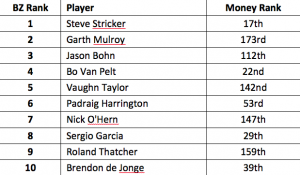
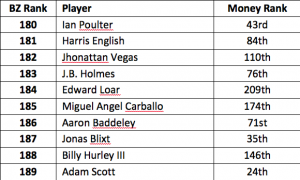
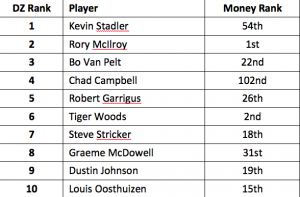
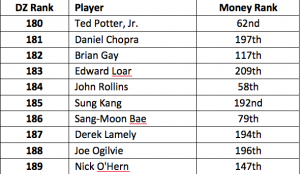












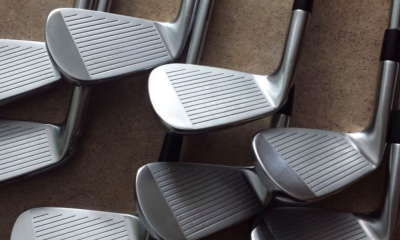













Louis
Aug 10, 2014 at 5:25 am
You say a player who averages 15 feet from 100 yards has a slim chance of making birdie because tour pros only make 20% of their 15 footers. How about all the shots that land inside 15 feet though?
If you hit 30 shots and average 15 feet from 100 yards it means you will have 4 putts inside of 4 feet (let’s say you make 4), 6 from 5-10 (let’s say you make 3), 5 from 11-15 (let’s say you make 2), and 15 from 15-30 (let’s assume you make 2). That gives you a better than 33% chance of making birdie.
Winning tournaments comes from making birdies and not screwing up badly. Going from a 7% margin of error to 5% margin of error with long irons isn’t gonna make you score any better.
Not spraying your long irons will help immensely. Because that’s a really easy place to lose strokes.
Lesson: keep the ball in play (hit greens) with your long irons. That’s it. Don’t worry about being better than able to hit it within 50 feet of where you aim consistently (still hard to do). Going from 50 feet to 40 feet won’t help.
Eliminate inconsistencies that produce big misses.
Once you have that down, to score well, hitting the wedges closer is the easiest way.
Sam
Jun 18, 2013 at 5:33 am
Interesting stuff, here’s my 2cents worth…
PGA Tour players are just like other golfers, they follow trends. In the 90’s everyone on Tour jumped on the 52, 56, 60 bandwagon with Tom Kite, when he took distance control to a new level. Then along came Tiger with 48, 54, 58 and they all dumped a wedge. Lately, club lofts have changed the make up of sets, making 3 iron redundant in many cases (as shown above). The reason the DZ looks more important to scoring than the BZ is that relative to the other parts of their game the average PGA Tour Pro is poor in the BZ. The reason for this is simple: not enough tools to do the job. Modern PW clubs have become much stronger, instead of keeping the loft/distance gaps even, everyone followed Tiger and minimized the short end of their set. No doubt, more options and more full shot yardages will result in closer to the hole with wedges, it would be interesting to look at the correlation between number of scoring clubs and proximity to the hole, pretty sure you will find that guys with 3-4 wedges get it closer more often than the two club guys. Now that’s a blind spot!
JD
Nov 13, 2013 at 5:15 am
Interesting comment. But what I think you have failed to recognise is the fact PGA tour courses have become much longer and therefore require more clubs down the long end of the set make up. As a professional caddie and also a pro myself I have seen this first hand. There are also more courses with par 3 holes that are between 200-225 yards, couple that with longer par 4 holes that require longer, higher and softer shots players are forced into a hybrid as well as 3 irons. This is one reason I feel players are dumping the extra edge.
Mike
Feb 21, 2013 at 10:11 pm
The article is interesting but I am not sure that using Money List as a correlation to Birdie/Danger Zone is a statistically sound method. The Money List is a total of earnings but that is subject to a variable you have not accounted for which is the number of starts a player has on the Tour. Even an average PGA Tour player will have more money when they have more starts. A better comparison of earnings to player performance statistics would at least use “earnings per start” to eliminate the variable related to the number of starts.
Also, isn’t there some relationship between BZ, SZ and DZ that you have not accounted for? For example, Steve Stricker rates Top 10 in BZ and DZ efficiency and Adam Scott is 189th in BZ and obviously not Top 10 in DZ. One would think, based on the analysis, that Adam Scott would finish far below Steve Stricker yet the opposite is true. Scott (16 starts) actually finished with slightly higher earnings per start ($181,000) than did Stricker (19 starts and $180,000 per start).
Alex
Feb 14, 2013 at 2:40 pm
First of all great article…
Last year i actually kept record of 30 rounds and analyzed them through out. I took lowest 10 rounds and see what i did best during those rounds. This is what i found. 7 out of 10 rounds i hit 12 fairways each of those rounds, however also note i took more 3 woods and hybrids off the tee that left me a lot of 150-185 yard approaches. In those rounds i hit about 14 greens on avg. What this concluded for me is that i am a lot better hitting 7,6,5 and hybrids off the fairway than wedges from the rough. I am pretty decent putter and will not really 3 putt very often, however i will also not drain too many 20 footers for birdies. If Tour avg from the BZ is about 20 ft then i will be definitely over that, so as an amateur if i want to score better but more importantly consistently better i should be hitting 3/5 woods off the tees and hitting 7 irons into greens taking my 2 putts and going to the next hole. This is where this article is dead on, for me to get better either i need to drive better and be on the short grass with my driver leaving wedges in or improve my approaches from 150-185. Now what is easier to improve….
Jeff
Feb 14, 2013 at 12:00 pm
Great article, really can relate to this.
Dane
Feb 13, 2013 at 2:01 pm
Great article Mark. Being a golf professional this has put into writing what plenty of golf pros think. I will definitely look more into your work!
Philip
Feb 8, 2013 at 11:30 am
Wow! I think I need to become a statistician to analyze my golf game! Call me weird, but these are fun articles!
mark burk
Nov 5, 2012 at 9:28 am
All of the players you metion are good danger zone players are longer hitters and bad dangerzone players are short hitters. 175 to 225 for the good ones mention are mostly mid irons that can hold the firm pga tour greens, they also will be able to hit par 5’s in two more often which is where these guys make there birdies with shorter clubs and since most the par 3’s on tour are over 200 yards plays to the advantage of the longer hitters. So it would be better most of the world class player have good long game because of distance. If you want to talk about where weekend warrior can save shots it is with the shortgame. If a player can eliminate 3 putts and get up and down more often it will save them more strokes than being a good iron player from 175 to 225. Keeping the ball in play, eliminating 3 putts and decent short game will keep the score down for the average weekend golfer. Every time I go to range at my club the chipping and putting green are empty and the range is full. What will lower a score faster going from 38 putts a round to 30 or hitting good long iron or hybrid shots which will maybe be hit 4 times a round. This is for the weekend player
Richie Hunt
Nov 7, 2012 at 9:54 am
Mark,
I only showed the top-10 and bottom-10, but there is no substantative statistical correlation between distance off the tee or clubhead speed or a combination of the two and DZ play. And I have ran these numbers since 2003 for Distance and DZ play and thru 2007 for clubhead speed and DZ play.
There are plenty of examples of shorter hitting, low clubhead speed players that play great from the DZ each year. McDowell is ranked 8th in the DZ and not very long. Same with Stricker. Furyk is ranked 12th and routinely does great in the DZ. Same for other shorter hitters like David Toms (who was ranked #1 in 2011), Heath Slocum, and Zach Johnson.
Meanwhile there are longer hitters that struggle from the DZ. Like Chopra, Driscoll, Lamely, and Mark Anderson (currently ranked 174th) and Jhonattan Vegas (currently ranked 175th).
Distance helps…slightly. But it’s not enough help for Tour players to overcome a lack of skill in the Danger Zone.
Brett Adamkiewicz
Nov 1, 2012 at 11:03 am
What a well rounded article, and explained better than I have ever heard it. I have always taken a different thought process compared to the average joe. Not to exaggerate but we have all heard the phrase “drive for show and putt for dough” a million times. Fact of the matter is you will never win any “dough” if your superb putting skills are saving bogey and double bogeys all the time. On a side topic I am curious as too the percentage of penalty strokes taken in a round are due to tee shots and the “danger zone” shots. I know the phrase doesn’t exactly fit with the danger zone but it is all relative. 175 and out is what I call my scoring zone. I can have a bad putting and chipping day and still be sub 80. If I can’t get off the tee and can’t get around the green, the limit on my score…. I am taking a trip with 7 of my buddies to Kiawah Island this weekend and I am going to put this to the test! Most of them are all mid to low handicappers and can play well! I am going to have a little fun with this and track their scoring relative to your “Danger Zone” and off the tee. Thank you for this article and I hope more people will read this and pay attention.
Brett Adamkiewicz
Nov 1, 2012 at 11:05 am
The sky is the limit on my score. Left out that part.
Dan
Oct 31, 2012 at 8:12 pm
Fantastic article, very insightful. It will be great to stop focusing on the “Glamorous” parts of the game and focus more on the shots that lower my score.
DaleH
Oct 31, 2012 at 5:02 pm
Exactly.. most amatures do struggle with the short game but really struggle with longer irons like myself. I’m usually on hitting into greens with say an 8 iron or less, 7-4 not as good, the longer the iron the the less my chances. Time to practice more on the long irons. Thanks for the facts.
Pingback: GolfWRX.com – The blind spot of PGA Tour players: Long-iron play | Golf Products Reviews